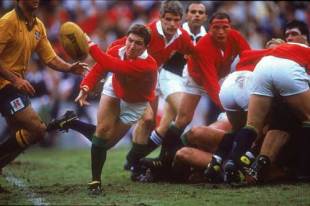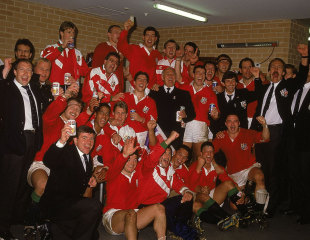|
The 1989 British & Irish Lions series
The 'Battle of Ballymore' re-booted
Tom Hamilton in Melbourne
June 28, 2013

Robert Jones wings the ball out from the back of the scrum
© Getty Images
Enlarge
Before last Saturday's first Test between Australia and the British & Irish Lions, two men, with 120 caps between them, carried the Tom Richards Cup on to the Suncorp Stadium turf. They have won a host of trophies and even share a similar surname, but basic facts and figures do not do justice to the rivalry Nick Farr-Jones and Rob Jones experienced back in 1989. Jones was working at a leasing company when he got the call-up from the Lions. He had grown up watching the likes of Gerald Davies, JPR Williams and Phil Bennett at his family home in Trebanos and in 1989 he was handed the chance to follow in their illustrious footsteps. He played in three of the Lions' warm-up games prior to the first Test against the Wallabies and the tourists had managed to maintain a 100% winning record. There was a confidence in the camp. But the Wallabies were an unknown quantity. Unlike the current series, the Lions had played against the majority of the Wallabies in their club colours before their first meeting. The provincial sides had caused the tourists limited difficulty, but that sense of invincibility proved to be the Lions' undoing. The Lions crashed to a 30-12 defeat. In Jones' own words, the Lions were "complacent" and it "went pear shaped". The tourists' coach Ian McGeechan unceremoniously dropped fly-half Craig Chalmers from the side and handed the No.10 shirt to Rob Andrew. But the legendary Lion kept the faith with Jones and he did his best to wind up his scrum-half in the week between the first and second Test. It proved to be a masterstroke. "Ian McGeechan is a fantastic coach and a guy who could get the best out of people," Jones told ESPN. "He came to the fore after the first Test. He spoke to me about how good and influential Nick Farr-Jones was. He was a major strength for them, but we needed to work out how to get him off his game and make him a weakness.
"All week it was based around that, with McGeechan constantly chipping away at me and talking to me about the influence he had and that if somehow I could knock him off his game and disrupt the way he plays then that would disrupt Australia. When someone is talking to you and sending you those messages at breakfast, lunch and dinner it does get to you. "Geech knew what made me tick and he knew that he could get under my strings and send the right messages me. I almost knew in the morning at our team meeting we were going to win. "McGeechan also spoke about how he had not been able to speak to his children on the telephone after the first Test because he was so upset and disappointed. He asked us if we could help him make it happen that week. It was little things like that pushed us up to a point that when we got on the field, it was right." And just a minute into the game, all hell broke loose with Jones and Farr-Jones at the epicentre. Jones wound up his Australian counterpart and after a fair few punches went in from both sides, Farr-Jones came off worse with the photograph of him walking back from the ruck bloodied and with his shirt ripped, now one of the game's most striking images. It was a game later labelled 'The Battle of Ballymore'.
"I had a job to do and when it came to that first scrum I stepped on his foot and people have seen that on video clips of that game," Jones remembers. "He reacted and we all responded and there was air of concern among the Australian players and you know, that's what we wanted. That helped turn the momentum and perhaps the start of their undoing in terms of that Test series. "I had been wrestling with Farr-Jones and when I got up off the ground and I looked back at our players and their players and from that moment on I thought, 'we've won this'." The Lions secured a 19-12 victory in Ballymore which set up the series decider a week later. But rather than focusing on their own weaknesses, the Wallabies took to the press to vent their frustration at the violence in the second Test. Farr-Jones predicted "open warfare" in the third Test and called for added protection from the officials. It was an outburst which backfired.

The Lions celebrate their series win over the Wallabies
© Getty Images
Enlarge
"They moaned, groaned and winged about our dirty play and me and that played into our hands," Jones added. "We got the result we were after as we went about our business quietly and effectively knowing that we had the upper hand. We had done what we set out to do. And we were confident leading up to the last Test and I felt we had the beating of them and I was proved right." Jones remembers he was running back to defend when David Campese threw the infamous pass to Greg Martin which allowed Ieuan Evans to score in the third Test. And while it proved to be decisive, there was plenty of rugby left in the game after the Lions had bagged that try. They held on for a narrow 19-18 triumph and for Jones, it was a seminal moment in his career. When the Lions took to the field in 1989, the feats of the 1971 and 1974 tourists were still in living memory but Jones and his team's achievement of winning the Test series in 1989 should not be overlooked. It was a hugely impressive feat and one Jones is proud to have been a part of. "They kept coming at us and we managed to hold on. It was a fantastic occasion. Test series are hard wherever you go. While Australia were previously behind the Boks and the All Blacks, with the likes of Lynagh and Campese they were on the way to becoming the best side in the world. And we realised that but thankfully we managed to do a job on them." © ESPN Sports Media Ltd. Tom Hamilton is the Assistant Editor of ESPNscrum.
| |||||||||||||||
Live Sports
Communication error please reload the page.
-
Football
-
Cricket
-
Rugby
-
- Days
- Hrs
- Mins
- Secs
F1 - Abu Dhabi GP
Abu Dhabi Grand Prix December 11-131. Max Verstappen ()
2. Valtteri Bottas (Mercedes)
3. Lewis Hamilton (Mercedes)
4. Alexander Albon ()
5. Lando Norris ()
6. Carlos Sainz Jr ()
-
ESPNOtherLive >>
Darts - Premier League
Golf - Houston Open
Snooker - China Open
Tennis - Miami Open

